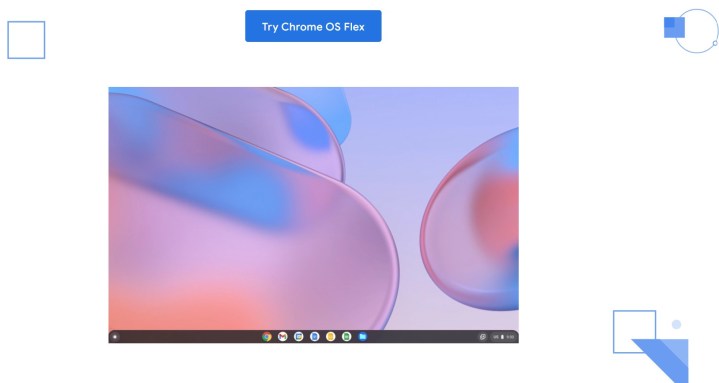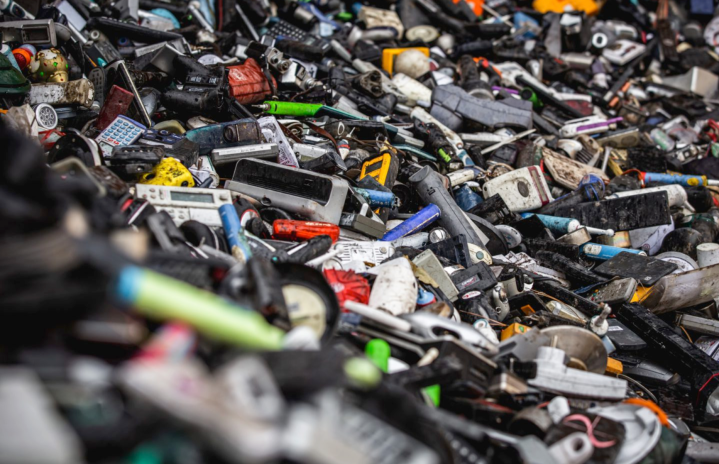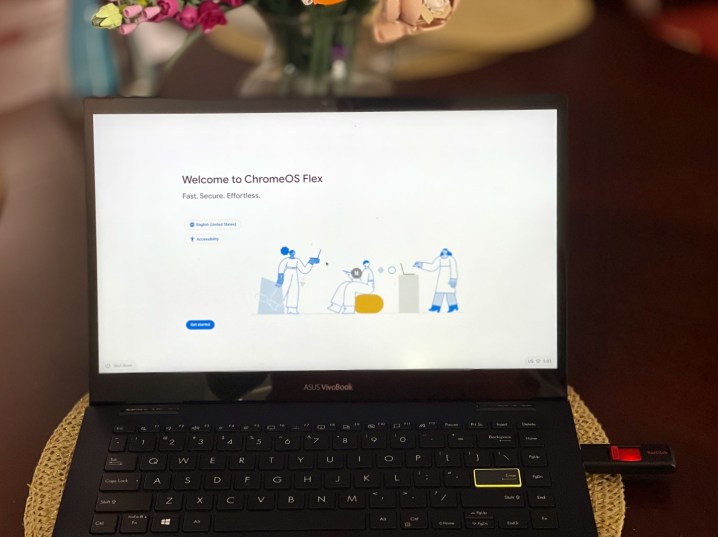If you have an older MacBook or Windows system somewhere around your house, there’s a chance you might that the device might be “too slow” or isn’t getting security or major operating system updates anymore.
Microsoft’s fading out of older Windows versions, strict requirements for Windows 11, and Apple’s allowing newer MacOS versions to run on select Macs might have your computer in the dust. Even in the enterprise space, it is very expensive to replace older devices.
That’s exactly the problem ChromeOS Flex is trying to address. Announced earlier this year and now exiting early access, it’s a free operating system from Google made to revive old systems and give them a new lease on life. I spoke with two leads from Google to hear more about ChromeOS Flex and what Google’s hopes are for one of the most interesting applications of ChromeOS we’ve ever seen.
Runs on all types of devices, including Macs
Unlike ChromeOS, which only runs on specific hardware that you must buy, the beauty of ChromeOS Flex is that it can run on almost any pre-existing hardware you want, for free. It also looks and behaves just like ChromeOS might.
If you’re up for it, all you need to do is visit Google’s website, follow the instructions, and install it using a USB drive on an existing PC or Mac. Google has basic minimum system requirements and a list of certified devices. In fact, Google certified more than 300 devices and is working to add more every day.
I was curious, so I asked what goes into that. Google told me that certification is a very intricate process, sometimes taking half a day. Google will go out and proactively certain certify certain devices that they think are popular in the market. Some of it is also reactive to what customers say. Google runs through a test suite with real people where some tests are automatic and some are manual.
“A lot of it is done with somebody in front of the device, ensuring that the actual user experience, including the responsiveness, the frame rates, the feel of the experience matches the bar we set,” said Michael Wendling, who is the lead product manager for ChromeOS Flex.

The cool part though is that people have ended up running it on hardware far beyond the scope of certified systems enterprise and education audiences that Google first imagined when it launched ChromeOS Flex in beta. You even can test drive the OS before you install it. This feedback is actually what Google wants.
“For us, it’s much more about our ambition. It is to go really big with this and really enable everybody to use it and benefit from it,” said Thomas Riedl, lead of ChromeOS product management across enterprise and education.
And yes, ChromeOS Flex works on Macs — mainly on older Macs machines that have x86 processors. Google isn’t sharing stats on which Macs are running ChromeOS Flex right now, saying that it isn’t the main userbase. But Michael Wendling told me that all generations of Windows PCs are running ChromeOS Flex — especially with Microsoft now limiting which devices can run Windows 11.
“That is a big motivation for a lot of customers. A lot of users will have a device that either is not able to upgrade to Windows 11 or the performance after the upgrade is unacceptable to them, so this gives them a path to get to a modern device,” said Wendling.
Good feedback

I installed ChromeOS Flex on an older Asus Vivobook I had in my drawer. And it worked just fine, including support for stylus and touch. Doing that helps Google build ChromeOS Flex. In fact, Google says that feedback like mine has been tremendous. Google saw a lot of creativity with ChromeOS Flex.
“One thing was, people were able to just really be creative. We have been very surprised at how many different devices and form factors ChromeOS Flex is on. They would find [a device] in their attic and just put it on and see what happens. Oftentimes, they would say something like ‘you just brought my old MacBook back to life!’ How cool is that?” said Thomas Riedl.
In other success stories, Riedl mentioned that people are surprised with how easy ChromeOS Flex is to use. ChromeOS Flex sets up in just a few clicks, and boots instantly. He also went on to mention that enterprise, schools, and IT admins, enrolled to try ChromeOS Flex, so they can turn older Windows or Mac devices around and manage them easily through Google’s tools and push policies through the Google Admin Console.
“So they’re not just only using the device but actually looking at how it feels and works within their fleet, which was great to see. We didn’t expect that right at the gate and that really helped us. We learned a lot. What it means to make sure this is really enterprise-ready,” said Riedl.
Not cutting into Chromebooks

At the top of my mind with ChromeOS Flex was if it would end up replacing Chromebooks. Would people stop buying Chromebooks and just use ChromeOS Flex on hardware they already own? It seems simple and easy enough.
Google assured me this isn’t the case. Google is seeing that some customers are interested in Chromebooks, and want to try them, but aren’t quite ready to buy for a variety of reasons. ChromeOS Flex lets that potential customer get that ChromeOS experience, before buying into the future since ChromeOS Flex is an equal partner to ChromeOS, with a few differences.
“This is really such a door opener. Within you know, just a couple of minutes, ChromeOS Flex is already downloaded. You try it out and you just use it on an existing device. So, we see this actually to be really helpful to have to start a conversation and take that friction out,” explained Riedl.
Basically, Google is taking what it has done in the last 10 years with Chromebooks together with their partners — and going further. It’s a way to reach more people, especially since ChromeOS Flex works with management tools from ChromeOS that let people deploy apps and set policies.
There’s also the fact that ChromeOS itself doesn’t run on all types of hardware outside of laptops. Say, large screen custom touch displays, kiosks, and other devices. ChromeOS Flex brings ChromeOS to new mediums.
“There is a huge diversity of form factors of devices with custom ports, that display sizes and built to hang on a wall and built to be on a countertop that there just aren’t chrome devices to satisfy. This allows us to satisfy the markets today,” said Wendling.
Based on Chrome OS

So, with ChromeOS Flex being around, you might wonder what happens with ChromeOS. Well, internally, Google is treating ChromeOS Flex and ChromeOS as the same development code base. There are some differences between the two, with the lack of the Google Play Store being the major factor.
Yet Google wants ChromeOS Flex and ChromeOS to live side by side, so customers can have two ways to access the same solution. This is why if you install it, you’ll notice that both operating systems share the same layers of security like ransomware, malware, and employee error protection. It is also why the user interface is identical — aside from an initial ChromeOS Flex boot and install screen that you’ll see.
Google’s Mike Wendling tells me that he also doesn’t see the two operating systems as having significant differences over time. He said a lot of the work done on ChromeOS Flex is also thanks to Google’s acquisition of Neverware (which was known for CloudReady, a way to run Chromium OS on PCs and Macs). Adding Neverware to ChromeOS helped create a larger engineering team.
“When the main ChromeOS organization is developing features, they’re developing without perspective for whether it’s ChromeOS or ChromeOS Flex. So, going forward, these features are brought forward for both platforms,” said Wendling.
There are a few other differences that Google points out in a support document. The most distinct difference between ChromeOS Flex and ChromeOS is the fact that Google doesn’t support Android Apps on ChromeOS Flex. It is something that Google is “continuing to look at,” according to Wendling.
I pushed for more details, and Thomas Riedl stepped in to answer. He tells me that the focus is for Google to build a stable OS first. The Google Play Store is something that they’re not prioritizing right now for ChromeOS Flex as they want to get it right first.
A lot of the work on ChromeOS Flex is also for building for education and enterprise, where the Google Play Store is not a key feature Instead, the web comes first there. Riedl also added that Android on ChromeOS Flex would be complex at the moment.
“The Google Play Store, it really means you have to bring Android to flex, right? So it’s yet another OS on top of another. And this is a very difficult complex endeavor. At the same time this is about really building the end-to-end experience and building it in a way that really works,” added Riedl.
The other difference between ChromeOS Flex comes down to Flex being enterprise and education-focused. ChromeOS, meanwhile, is more associated with specially manufactured Chromebook hardware with tight hardware aspects and features like firmware updates, TPM, encryption, Linux development, and support for Parallels. You won’t find those on ChromeOS Flex.
Unlike other lightweight solutions

Like Google ChromeOS, ChromeOS Flex is a lightweight and fast operating system. Thomas Riedl told me most customers were impressed with ChromeOS Flex in three different ways when compared to other lightweight operating systems like Linux.
Unlike Windows or other competing operating systems, Riedl says that most people consider the “gold standard” of operating systems when it comes to security. He went on to explain that hospitals and hotel chains use ChromeOS to avoid ransomware attacks.
The hotel chain Nordic Choice specially choose ChromeOS Flex to quickly replace the OS on compromised devices and get them back online. Riedl said that employees across 200 Nordic Choice hotels in Scandinavia were able to convert 2,000 computers in under 48 hours, protecting their business from a costly shutdown.
Next up, is how ChromeOS Flex is easy to use and manage and run since most people are familiar with Chrome. Riedl detailed how the call centers can easily re-image ChromeOS Flex devices and reduce training and increase employee turnover.
“It’s just super easy to put all that together. And that combination is is where we see us really win and, and get people to choose us over the other options,” said Riedl.
Reducing e-waste

The last point touched on in my sit-down with Google is how ChromeOS Flex reduces e-waste. Google says that 40 million tons of e-waste are generated every year which is like throwing away 800 laptops per second. Additionally, there’s the need to think about carbon footprint for buying and using new devices, too.
In particular, Google mentioned to me that ChromeOS Flex can breathe new life into existing hardware to reduce e-waste and energy consumption. Companies and individuals also don’t need to throw away devices.
“When companies put ChromeOS flex on devices, they see that they have a responsive and performance system that is snappy and fast, and that it wasn’t the hardware. So I think that’s the light bulb that goes off for people that this hardware actually can still be used and this plays into our sustainability story that the hardware is still capable,” said Wendling.
ChromeOS Flex consumes 19% less energy on average than other operating systems, per Google’s tests. And, with the hotel chain Nordic Choice, converting 2,000 computers to ChromeOS Flex will help save up to 1.5 million kilos of CO2 over the next eight years.
“The biggest thing for us is that already have that existing device and there’s no need to switch it out prematurely just because that operating system tells you you need to,” said Riedl.
Give it a shot
You can try ChromeOS Flex today if you want, and there’s little harm in giving it a shot. Thomas Riedl and Mike Wendling both told me that they’re excited to see what the community is coming together to do with ChromeOS Flex.
Before long, Wendling says, it might also feel like almost any device will be certified to run ChromeOS Flex as Google is always investing in resources to put the Chrome OS Flex where it belongs.
Editors’ Recommendations





